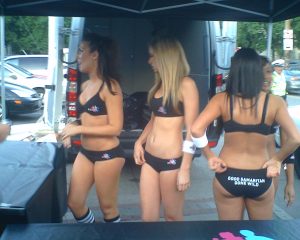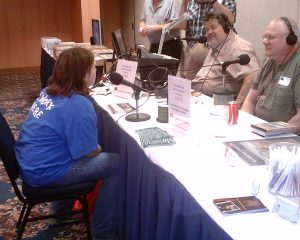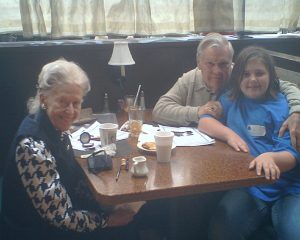My friend Scott and I went walking for the first time this calendar year. Much has interfered with walking these past several months–the snowfall, my persistent cough, the gallbladder surgery and the recuperation. Tonight, all the stars were in alignment. Our schedules meshed, the weather was beautiful, and I actually felt energetic.
We toured the new Ohio Union for the first time tonight, a beautiful structure with an excellent food court (we ate dinner there), and I was amused to see the lyrics of “Carmen Ohio,” the OSU alma mater, chiseled inside the main lobby. We each worship at our own unique shrines, I suppose.
Scott and I didn’t do as much walking as we planned. A friend had asked Scott to make sure all the doors were locked at a rental property he owns east of campus, and once that was done, I told Scott I wanted to swing by FedEx Office and buy a new notebook.
Getting close to FedEx Office (nee Kinko’s) was much easier said than done. The music at the O Patio and Pub was deafening, and the patio was at capacity. It almost had the atmosphere of Michigan weekend or pre-Notre Dame football. We asked around, and the first annual OSU AXE Undie Run was launching from there at 9 p.m. The idea of this event was to wear clothing you will donate to the homeless and run a little less than a mile in your underwear. (AXE, the sponsor, manufactures men’s toiletries.) The race kicked off in front of the O Patio (near the corner of E. 15th and High) and would end at Pearl Alley and E. 16th, about a block north, via a circuitous route around Iuka and Woodruff Aves. Ohio State was competing with nine other universities–whoever donated the most clothes (by weight) receives a half-naked statue.
As nine o’clock drew near, I admit I forgot all about buying a notebook. There was a genuinely fun atmosphere as both women and men stripped down to their briefs and bras. (The oldest participant was a man in his 60s, a memory I’m trying to exorcise from my head.) Scott and I enjoyed watching it. The atmosphere was festive, and I doubt any woman or man felt threatened in any way.
The title of this post refers to my realization (something I keep having to learn and relearn) that I’ve moved a generation away from the college crowd. I have haunted college campuses and environs for most of my life. My late father was an English professor at Marietta College, so we lived within blocks of the campus, and even at a young age I knew his students, as dinner guests, as babysitters, and later as friends. As a teen, I frequented the Gilman Student Center on the Marietta College campus, since it had the best pinball machines and the first video games in Marietta. In high school, I often hitchhiked to Athens (50 miles away) to drink or lose myself in the stacks at Alden Library. When I landed in Boston, I lived in Boston University’s student ghetto and earned my living typesetting The Crimson, which brought me in close proximity to the Harvard campus.
So now I am a generation removed. As Scott and I watched everyone stripping down for, and participating in, the Undie Run tonight, it came to me that these students were young enough to be my children. Many of them were born while I was at Ohio University in Athens. It was easy for me to forget this fact, since I didn’t become a parent until I was 34, but that is the exception, not the rule. (I still shudder, however, when I think of a woman who worked alongside me at the Cincinnati post office, 30 years old and already a grandmother.)
College is often the happiest time of many people’s lives, but there are certain college towns that students and alumni love so much that they never leave, and they become fixtures. Ann Arbor is like this, as is Athens, and so is Chapel Hill. I knew people in Athens who stayed and worked for degree after degree, and once they had exhausted this, took low-paying jobs in town just so they could remain in the college milieu.
The most obvious (and tragic) example of this was a guy I knew in Athens, whom I’ll call Dirk. He went to O.U. on the GI Bill in the late ’50s and graduated with a degree in education. He taught in several elementary and secondary schools in Appalachia, and in the mid-’80s, about when he turned 50, he decided to return to Athens for a master’s in special ed.
Dirk lived in an apartment off campus, and went to classes at O.U. for about a year and a half. Finally, his faculty advisor told him he was just wasting his money on classes, and that he would never be a good enough teacher. Nonetheless, he stayed on in Athens, living on an allowance from his mother, hanging out mostly with students 30 years younger, taking his meals in the cafeteria, etc. He was free with advice to students on how to conduct their romantic lives (though he was a lifelong bachelor), their academic lives (although he had washed out of his own program), and was a zealot about telling people to “act responsibly” (this from a man in his 50s living on his mother’s largess.) I am not a Christian, but you gotta wonder if Jesus of Nazareth knew such a person when he spoke: How can you say to your brother, “Let me take the speck out of your eye,” when all the time there is a plank in your own eye? You hypocrite, first take the plank out of your own eye, and then you will see clearly to remove the speck from your brother’s eye. (Matthew 7:4-5)
I was in the cusp between my college years and the kids I saw tonight while I lived in Cincinnati. As soon as I could afford it, I moved to an apartment in Clifton, near the University of Cincinnati, and the closest thing that Cincinnati would ever have to Greenwich Village. I set up shop in the Subway restaurant across from my commodious W. McMillan St. apartment, and developed a rapport, if not deep friendships, with many of the people who worked there. I was the one who made runs to the convenience store for cigarettes and beer, and, when the manager banned alcohol on the premises, the “sandwich artists” stored beer in my refrigerator.
Soon, I was permitted unlimited refills on soda pop, which I drank by the gallon, and even allowed to run tabs, which I paid off as soon as I was flush. Here is a page from my notebook (actually a pocket 1994 appointment diary) which listed my tab. The initials at the bottom are the manager’s, indicating that I had paid the debt in full.
TANGENT ALERT: Even as I was extending my adolescence well into my 30s, I did have my eyes out for bigger and better jobs and more exotic places to live. Some were practical, some outright unrealistic, as another page in the same pocket diary will show:
Planning to live as an expatriate in the Czech Republic
at the same time I was rolling pennies for bus fare–
realistic, eh?
The first signs that I was moving beyond being a peer was when I was in a conversation with some students at a bar near my place. Somehow we got on the subject of when we were first allowed to stay up late. I mentioned that the first time I was allowed to stay awake past dark was in July 1969, so I could watch Neil Armstrong and Buzz Aldrin land on the moon. By the reaction this wrought, you would think I was reminiscing about seeing off the Santa Maria on its voyage to the New World.
And I knew I was different from the kids working there. Some of the Subway workers called me “rabbi,” mainly because of my wire-rimmed glasses and my beard. (If I had joined the Hasidim, it would make my wardrobe more colorful, to be sure.) It was joking and respectful at the same time.
Many of the customers saw me as a fixture, as much as the fountain drink machine and the bright yellow booths. I was the guy who would sit there for hours, either writing in a big red journal or poring over Kerouac or Hemingway.
I even felt this to a small degree when I first arrived at O.U. as a student in the spring of 1984. I had the mystique of having lived in “the real world” for three years between high school and college–for a year unemployed, and two years working a “real” job. This also brought the added bonus of being the only person in a freshman dorm who could buy hard liquor. The age barrier goes up fast, but it was only tonight that I realized just how far removed I was. I remember shaking my head at a 1990 editorial in Clifton magazine (U.C.’s literary magazine, published quarterly) which mentioned the Kent State massacre. “We were alive then. We couldn’t walk yet, but we were alive.” I was in first grade then!
To make up for a somewhat depressing blog entry, I will post the few pictures I took at tonight’s Undie Run. I apologize for their quality. The flash on the camera was never that great, and the batteries are beginning to run low. But here they are:
Not exactly a motto that would meet Mother Teresa’s
approval, but “Philanthropy Just Got a Whole
Lot Sexier” has more allure than “Give the shirt
off your back.”
AXE’s professional staff, handing out complimentary
socks and wristbands until they were gone. GOOD
SAMARITAN GONE WILD might actually make
some teens return to Sunday school.
The man on the right manages the AXE Undie Run
Road Show. If he can land an Undie Run at Brigham
Young University, he has my undying respect and
awe.
Preparation for the event–one of many
police cars and emergency vehicles, and
one of many photographers and guys
from the dirty-raincoat contingent.
Preparations for the run itself, as 9:30 p.m. draws
ever closer. (They didn’t start until around 9:45,
actually.)
Day is done, gone the sun, and with it my
ability to take decent pictures. All pictures
taken afterwards were mostly silhouettes.
















